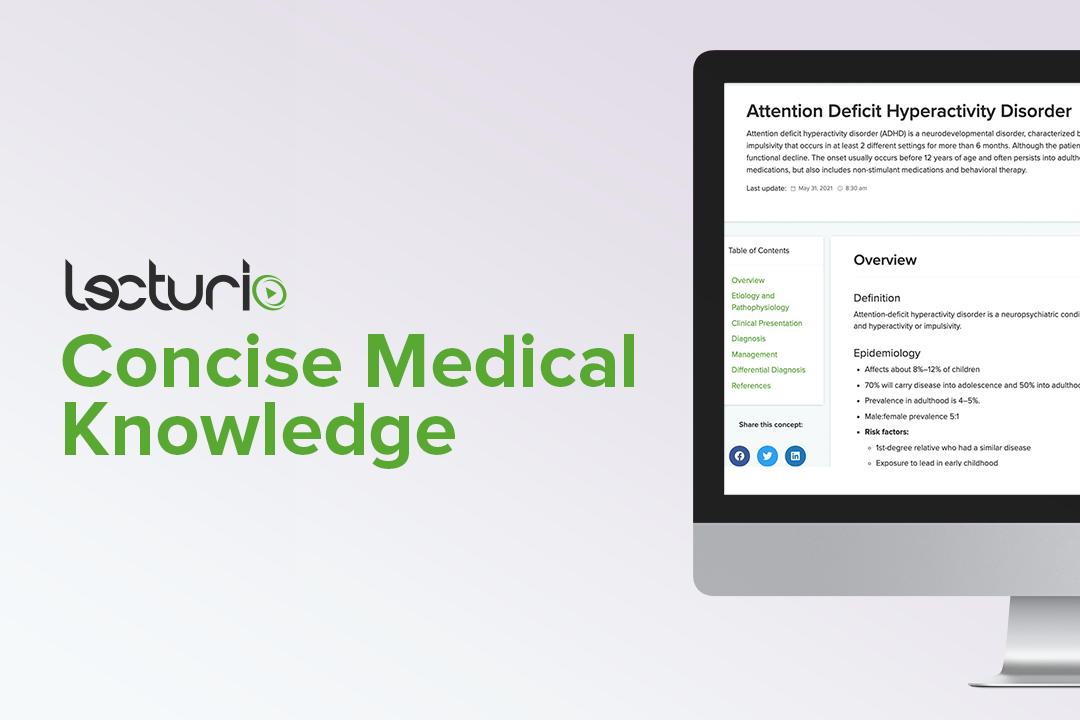Playlist
Show Playlist
Hide Playlist
Attention-Deficit/Hyperactivity Disorder (ADHD) in Pediatrics
-
Slides ADHD Pediatrics V2.pdf
-
Download Lecture Overview
00:01 In this lecture, we will discuss attention deficit hyperactivity disorder. 00:06 ADHD or attention deficit hyperactivity disorder is sometimes also called ADD or attention deficit disorder when there is less hyperactivity. 00:17 So there are really a few different types of ADHD and I want to discuss them with you. 00:24 It’s basically, in general, an impairment in functioning in at least two settings. 00:29 Usually, home and school, due to impulsivity, inattention, or hyperactivity. 00:36 So let’s discuss the three major types. 00:39 We have the combined type which is the most common. 00:42 Patients with this problem have difficulty with attention and focus and have some hyperactive or impulsive behavior. 00:50 In the inattentive type, which is the second most common, they may have difficulty with attention, but there is no significant hyperactive or impulsive behaviors. 00:59 And then in the hyperactive-impulsive type which is less common, there’s less problems with attention and it’s more common maybe in preschoolers where they mostly have the hyperactive component. 01:12 So there seems to be some genetic predisposition to this problem. 01:17 Boys are much more likely than girls to get the problem. 01:20 A child of a parent with ADHD has a 25% chance of developing ADHD themselves. 01:28 Also, there is a 55-90% monozygotic twin concordance. 01:33 In other words, there seems to be some strong genetics at work here. 01:37 There are also syndromes that are genetic that are predisposed to developing ADHD. 01:44 Children with Klinefelter’s, children with Turner’s, children with fragile X, children with neurofibromatosis type 1 or Williams syndrome or even DiGeorge syndrome are at increased risk for attention deficit hyperactivity disorder. 01:59 So there are also, however, environmental factors at work. 02:05 Patients with lower socioeconomic status are more prone to the problem, as our patients with parents who have mental disorders. 02:13 Children in foster care are more likely to have ADHD. 02:17 Children who were of low birth weight or prematurity are more likely to have ADHD. 02:21 And children with acquired traumatic brain injury may develop ADHD. 02:27 So ADHD may present differently depending on the age at which that child is being brought to attention. 02:34 In the preschool era, hyperactivity is usually a larger component. 02:39 These patients may be impulsive. 02:41 They are not flexible with their environment. 02:44 In other words, if something has significantly changed, they don’t tolerate it very well. 02:48 And they may be aggressive with their peers. 02:51 In the elementary school era, these children now start to struggle with listening in class. 02:56 They have poor organizational skills. 02:59 They struggle with social interaction. 03:01 And they may have difficulty functioning independently. 03:04 And as adolescents, they have a problem with academic demands. 03:11 As high school starts and these children have increased responsibility academically, they can really start to struggle. 03:18 And they can start to struggle with attention, learning, and even executive functioning.
About the Lecture
The lecture Attention-Deficit/Hyperactivity Disorder (ADHD) in Pediatrics by Brian Alverson, MD is from the course Child Development and Behavior.
Included Quiz Questions
Which of the following is NOT a symptom of ADHD in elementary school age children?
- Obsessions
- Struggling with listening in class
- Poor organizational skills
- Struggling with social interaction
- Difficulty functioning independently
Which of the following is not a risk factor of attention-deficit/hyperactivity disorder in children?
- Large for gestation age or macrosomia
- Klinefelter’s syndrome
- Turner’s syndrome
- Fragile X syndrome
- Neurofibromatosis type 1
A boy presents with his mother following reports inattention to what is being taught in class. There have been no significant hyperactive or impulsive behaviors. Which of the following is the most likely diagnosis?
- ADHD, inattentive type
- ADHD, combined type
- ADHD, hyperactive-impulsive type
- OCD
- Depression
Customer reviews
4,0 of 5 stars
| 5 Stars |
|
0 |
| 4 Stars |
|
1 |
| 3 Stars |
|
0 |
| 2 Stars |
|
0 |
| 1 Star |
|
0 |
Good lecture. It is an important topic in pediatrics indeed. Thanks!




